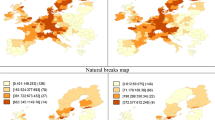Abstract
The aim of the paper is to investigate the process of spatial agglomeration of innovation and production activities and to assess the extent to which the degree of specialisation or diversity externalities in the area may affect the innovative output in a particular local industry. The analysis is carried out thanks to an original databank on innovation and production activity across 85 industrial sectors and 784 Italian Local Labour Systems, which are groupings of municipalities characterised by a high degree of self-contained flows of commuting workers. According to the global and local indicators of spatial association there are clear signs of spatial correlation in the distribution of innovation activities. The econometric analysis shows that the two types of externalities – specialisation and urbanisation economies – are both effective. Moreover, we find evidence for knowledge spillovers since technological activities of a local industry influence positively innovations of the same sectors in contiguous areas.
Similar content being viewed by others
References
Anselin L., 1988: Spatial Econometrics: Methods and Models. Kluwer Academic Publishers, Dordrecht.
Anselin L., 1995: Local Indicators of Spatial Association — LISA. Geographical Analysis 27: 93-115.
Arthur W.B., 1988: Self-reinforcing Mechanisms in Economics. In: Anderson P., Arrow K. and Pines D. (eds), The Economy as an Evolving Complex System. Addison-Wesley Publishing Company, Redwood City.
Audretsch D. and Feldman M., 1996: R&D Spillovers and the Geography of Innovation and Production. American Economic Review 86: 631-640.
Bartelsman E., Caballero R. and Lyons R., 1994: Customer-and supplier-driven externalities. American Economic Review 84: 1075-1084.
Becattini G., (ed.), 1987: Mercato e Forze Locali. Il Distretto Industriale. Il Mulino, Bologna.
Breschi S., 1997: The geography of innovation: a cross-section analysis. CESPRI WP, No. 95 Università Bocconi, Milano.
Brouwer E., Budil-Nadvornikova H. and Kleinknecht A., 1999: Are urban agglomerations a better breeding place for product announcements. Regional Studies 33: 541-549.
Brulhart M., 1998: Economic geography, industry location and trade: the evidence. World Economy, 21: 775-801.
Brusco S., 1982: The emilian model: productive decentralisation and social integration. Cambridge Journal of Economics 6: 167-184.
Camagni R., (ed), 1991: Innovation Networks: Spatial Perspectives. Belhaven Press, London.
Caniels M., 1999: Knowledge Spillovers and Economic Growth: Regional Growth Differentials across Europe. Edward Elgar, Cheltenham.
Capello R., 1999: Spatial transfer of knowledge in high technology milieux: learning versus collective learning processes. Regional Studies 33: 353-365.
Cheshire P. and Hay D.G., 1989: Urban Problems in Western Europe: an Economic Analysis. Unwin Hyman, London.
Coe D. and Helpman E., 1995: International R&D Spillovers. European Economic Review 39: 859-887.
Cooke P. and Morgan K., 1994: The creative milieu: a regional perspective on innovation. In: Dodgson M. and Rothwell R. (eds), The Handbook of Industrial Innovation. Edward Elgar, Cheltenham.
Ellison G. and Glaeser E, 1999: The geographic concentration of industry: does natural advantage explain agglomeration? American Economic Review Papers and Proceedings 89: 301-316.
Evenson R., 1993: Patents, R&D and invention potential: international evidence. American Economic Review Papers and Proceedings 83: 463-468.
Feldman M., 1994: The Geography of Innovation. Kluwer Academic Publishers, Dordrecht.
Feldman M. and Audretsch D., 1999: Innovation in cities: science-based diversity, specialization and localized competition. European Economic Review 43: 409-429.
Glaeser E., Kallal H., Scheinkman J. and Sheifler A., 1992: Growth of cities. Journal of Political Economy 100: 1126-1152.
Henderson V, Kuncoro A. and Turner M., 1995: Industrial development of cities. Journal of Political Economy 103: 1067-1090.
ISTAT 1998: Statistiche sulla ricerca scientifica e l'innovazione tecnologica. Roma.
Jacobs J., 1969: The Economy of Cities. Jonathan Cape, London.
Jaffe A., Trajtenberg M. and Henderson R., 1993: Geographic localisation of knowledge spillovers as evidenced by patent citations. Quarterly Journal of Economics 108: 577-598.
Kelly M. and Hageman A., 1999: Marshallian externalities in innovation. Journal of Economic Growth 4: 39-54.
Krugman P., 1991: Economic Geography and Trade. MIT Press, Cambridge, MA.
Lamorgese A., 1997: Externalities, economic geography and growth: a cross-section analysis. CESPRI WP, No. 100.
Lawson C. and Lorenz E., 1999: Collective learning, tacit knowledge and regional innovative capacity. Regional Studies 33: 305-317.
Lucas R.E., 1993; Making a miracle. Econometrica 61: 251-272.
Marshall A., 1890: Principles of Economics. Macmillan, London.
Maskell P. and Malmberg A., 1999: Localised learning and industrial competitiveness. Cambridge Journal of Economics 23: 167-185.
Ottaviano I. and Puga D., 1998: Agglomeration in the global economy: a survey of the ‘new economic geography’. World Economy, 21: 707-731.
Paci R. and Usai S., 2000a: Technological enclaves and industrial districts. An analysis of the regional distribution of innovative activity in Europe. Regional Studies 34: 97-114.
Paci R. and Usai S. (2000b) The role of specialisation and diversity externalities in the agglomeration of innovative activities. Rivista Italiana degli Economisti (in press).
Pyke F., Becattini G. and Sengenberger W. (eds) 1990: Industrial Districts and Inter-Firm Co-operation in Italy. International Institute for Labour Studies, Geneva.
Romer P., 1986: Increasing returns and long-run growth. Journal of Political Economy 94: 1002-1037.
Sforzi F. (ed.), 1997: I sistemi locali del lavoro 1991. Argomenti no.10. ISTAT, Roma.
Verspagen B., 1999: European regional clubs: do they exist and where are they heading? On economic and technological differences between European regions. In: Adams J. and Pigliaru, F. (eds), Economic Growth and Change. Edward Elgar, Cheltenham.
Von Hippel E., 1995: Sticky information and the locus of problem solving: Implications for innovation. Management Science 40: 429-439.
Author information
Authors and Affiliations
Rights and permissions
About this article
Cite this article
Paci, R., Usai, S. Externalities, knowledge spillovers and the spatial distribution of innovation. GeoJournal 49, 381–390 (1999). https://doi.org/10.1023/A:1007192313098
Issue Date:
DOI: https://doi.org/10.1023/A:1007192313098




